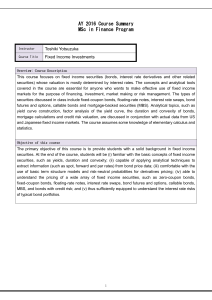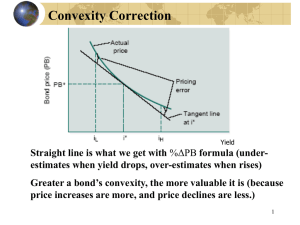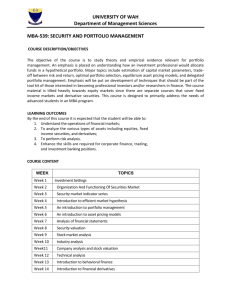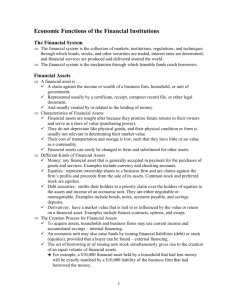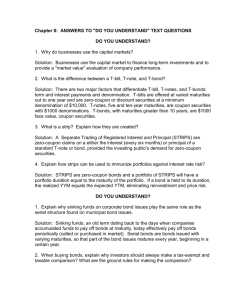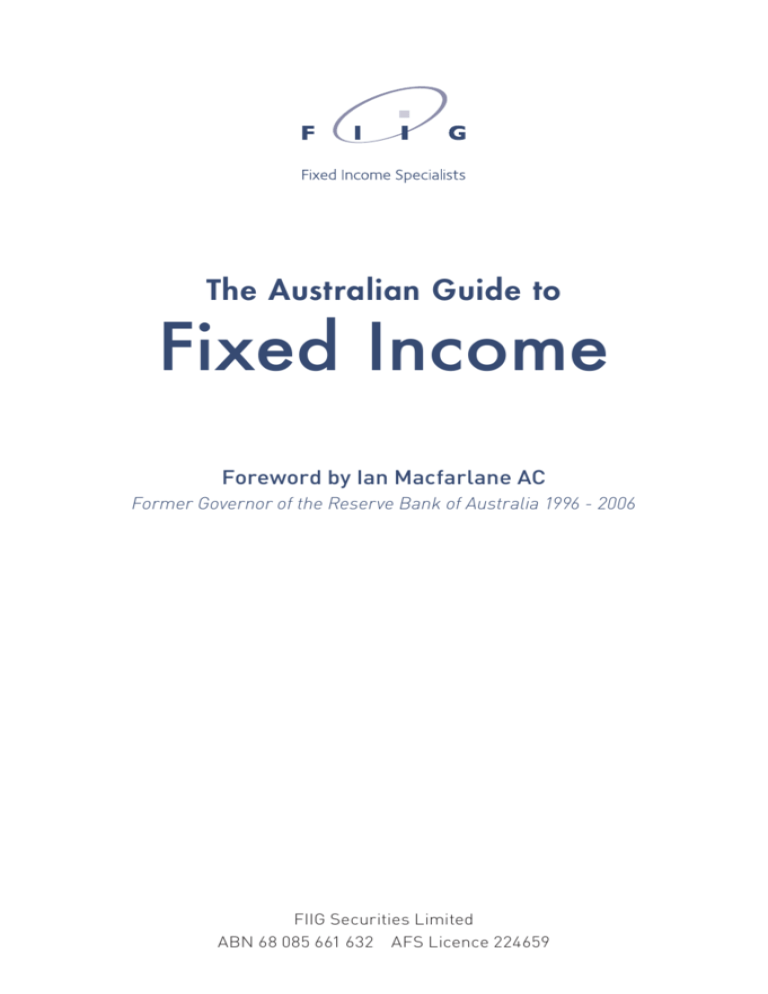
The Australian Guide to
Fixed Income
Foreword by Ian Macfarlane AC
Former Governor of the Reserve Bank of Australia 1996 - 2006
FIIG Securities Limited
ABN 68 085 661 632 AFS Licence 224659
Foreword
Ian Macfarlane AC
Former Governor of the
Reserve Bank of Australia 1996 - 2006
Volatility in financial markets over recent years has
caused many investors to reappraise the level of risk
in their investment portfolios and has led to heightened
interest in prudent asset allocation and hence fixed income
investments.
Direct investment in the fixed income asset class such
as corporate bonds remains underdeveloped in Australia
compared to other developed countries. Over recent years,
governments, regulators, political and business leaders,
economists, financial commentators and the media have all
called for greater effort to be put into the development of
the corporate bond market in Australia. This would provide
greater opportunities for companies seeking additional
means of raising capital as well as for investors seeking
lower risk investments.
Investment in fixed income such as corporate bonds is
designed mainly to conserve capital and provide income.
Generally, fixed income investments exhibit both lower
volatility and more certain returns than equities over long
periods and, because returns from fixed income and other
asset classes are not highly correlated, incorporating bonds
into a balanced investment portfolio can reduce expected
risk for a given rate of return.
Investors new to the fixed income asset class can
sometimes feel inundated with new terms and calculations.
In response to this, in 2009 FIIG published The Australian
Guide to Fixed Income as a reference book to demystify fixed
income investments and to provide information about how
to access fixed income financial products. In this Second
Edition, as well as updating the entire book, important
additions have been included. PricewaterhouseCoopers
has contributed a chapter on tax which most investors
will find useful. Also there are new chapters on hybrids,
inflation linked bonds, an introduction to credit analysis, and
investment and trading strategies.
Education is a vital element for developing corporate bond
investment and issuance in Australia. The Second Edition of
The Australian Guide to Fixed Income is a welcome addition
to the information available to investors, issuers, legal and
accounting professionals, financial and wealth advisors,
educators, students and anyone interested in understanding
the fixed income asset class in Australia.
I recommend The Australian Guide to Fixed Income to
people interested in expanding their financial literacy on this
most important topic and commend FIIG for producing this
excellent reference work.
Ian Macfarlane AC
Publisher
This guide has been
published by
FIIG Securities Limited
ABN 68 085 661 632
AFSL 224659
ISBN 978-0-9922738-0-4
Editor
Elizabeth Moran
Editor’s Assistant
Daria Pakina
Sub Editors
Douglas Bates
Cameron Coleman
Foreword
Ian Macfarlane AC
External Editors
Melanie Clark
Virginia Stirling
Contributors
William Arnold
Bianca Burt
Mark Dodds
James Finlay
Emma Jenkin
Jon Lechte
Gavin Madson
Elizabeth Marriott
Justin McCarthy
Dr Stephen Nash
Tony Perkins
Ryan Poth
Henry Stewart
Marita Sweeney
PwC Contributors
Ernest Chang
Rosalind Myint
© FIIG Securities Limited 2013. All rights reserved. No part of this publication may be reproduced,
stored in a retrieval system, or transmitted in any form or by any means, electronic, mechanical,
photocopying, recording, or otherwise, without written permission of the publisher.
The Australian Guide
to Fixed Income
1
Contents
Key aspects of fixed income 10
Fixed income – a definition 12
Section 1. The fundamentals 13
Chapter 1. Why fixed income? 15
1.1 Capital stability 15
1.2 Regular income 16
1.3 Diversification 16
1.4 Ability to earn better returns than bank deposits 16
1.5 Ability to diversity the range of portfolio maturities 17
1.6 Liquidity 17
1.7 Protection against loss in a cyclical downturn 18
Chapter 2. Features of fixed income – what you need to know 19
2.1 Interest rates 19
2.2 Yields and the yield curve 23
2.3 New issues and secondary markets 27
2.4 Discounts and premiums 28
2.5 How changing interest rates impact bond prices 28
2.6 Duration 30
2.7 Credit risk 35
2.8 Liquidity risk 39
2.9 Credit ratings 39
2.10 Bond market indices 45
2.11 Calculations 46
Contents
5
Chapter 3. Fixed income products 3.1 Why companies issue fixed income products 49
3.2 Term deposits (TDs) 50
3.3 Money market securities 52
3.4 Bonds 56
Case study 59
3.5 Hybrids 66
3.6 Structured products 68
Chapter 4. Capital structure 71
4.1 Funding 71
4.2 Capital structure levels 72
Chapter 5. Risk versus reward continuum Case study: major Australian bank Chapter 6. Asset allocation 77
81
83
6.1 How exposure to interest rate risk (duration) helps portfolios hedge against the
volatility of higher risk assets 85
6.2 Credit 90
6.3 Fixed income in a balanced portfolio 90
6.4 Rebalancing a fixed income portfolio 100
6.5 Other considerations in asset allocation 101
Chapter 7. Building a fixed income portfolio (including a sample) 103
Chapter 8. Regulators of the Australian fixed income market 111
8.1 The Australian Prudential Regulation Authority (APRA) The Australian Guide to Fixed Income
6
49
111
8.2 The Australian Securities and Investments Commission (ASIC) 117
8.3 The Australian Securities Exchange Group (ASX) 118
8.4 The Corporations Act 2001 and other legislation 120
Section 2. For more technical investors 123
Chapter 9. Hybrids 125
9.1 Definition 125
9.2 Market overview 126
9.3 Evolution of the hybrid market 130
9.4 What drives hybrid issuance? 131
9.5 Key structural features of hybrids 133
9.6 Types of hybrid securities 134
9.7 Conclusion 137
Case study: Crown Group Finance Limited (Crown):
an example of an equity credit security 138
Case study: Goodman Australia Industrial Fund Bond Issuer Pty Ltd
(Goodman): an example of a step up security where the investor was not
given the option of repayment and instead offered a coercive exchange 139
Chapter 10. What happens when banks fail (a case study) 141
Chapter 11. Inflation linked bonds 149
11.1 The history of inflation 149
11.2 How is inflation measured? 150
11.3 Ways to protect against inflation 151
11.4 Two main types of inflation linked bonds 151
Chapter 12. Residential Mortgage Backed Securities (RMBS) 157
12.1 What are Residential Mortgage Backed Securities? 158
12.2 The RMBS process and participants 159
12.3 How are RMBS investors protected? 162
12.4 Upcoming developments in RMBS 166
Chapter 13. An introduction to credit analysis 1
169
13.1 Sovereign and country risks 169
13.2 Industry risks 170
13.3 Business risks 170
13.4 Management 171
13.5 Financial risk analysis 172
Case study: Qantas Airways Ltd 175
Contents
7
Chapter 14. Investment and trading strategies 14.1 Economy starts to contract 180
Case study: Commonwealth government bonds 181
14.2 The economy and the cash rate reach the low point in the cycle 183
14.3 The economy is growing and the RBA is starting to increase the
cash rate to limit growth 184
14.4 The economy and the cash rate reach the high point in the cycle 185
14.5 Other strategies throughout the cycle 186
Section 3. Investing in fixed income 191
Chapter 15. Accessing the bond market 193
15.1 A brief overview of the Australian bond market 193
15.2 Direct ownership 194
15.3 Indirect investment in fixed income 197
Chapter 16. Buying and selling bonds and other fixed income products The Australian Guide to Fixed Income
8
179
201
16.1 Bonds 201
16.2 New issues 202
16.3 Australian Securities Exchange (ASX) listed securities
(including exchange traded funds) 202
16.4 Investing in term deposits through FIIG 203
16.5 Opening a bond trading account with FIIG 203
Chapter 17. Coupon payments and bond maturity 205
Chapter 18. Tax 207
18.1 Taxation of interest income 207
18.2 Qualifying securities 207
18.3. Traditional securities 209
18.4 Taxation of Financial Arrangements (TOFA) provisions 210
18.5. Investments in a currency other than AUD 211
18.6. Provision of TFN/ABN 211
18.7 Frequently asked questions 212
Chapter 19. Issuers of Australian Dollar bonds 219
19.1 Australian issuers 219
19.2 International issuers (issuing AUD securities) 226
Section 4. Reference material 233
Chapter 20. Glossary 235
Chapter 21. Frequently asked questions 261
Chapter 22. Abbreviations 269
Appendix 1. Typical capital structure for an Australian bank 273
Appendix 2. Pricing formulae for Commonwealth government securities 275
References and further reading 283
1
Key aspects of fixed income
9
Key aspects of fixed income
1. Fixed income securities are low risk and provide
a defined income stream and capital stability.
2. Fixed income securities include: deposits,
bonds (senior secured, senior and subordinated)
and hybrids.
3. Unlike ordinary shares, the structure of fixed
income securities can vary significantly between
issues. Investors can tailor their holdings based on
term, interest rate structure and sensitivity, issuer
credit quality, subordination and other factors.
The Australian Guide to Fixed Income
10
4. Practically all fixed income securities rank
higher in the capital structure of an issuer than
ordinary shares. This means that if the company
enters liquidation, fixed income securities are
repaid before any funds can be returned to
shareholders.
5. Bonds provide good portfolio diversification
as returns typically have low correlation with
property and equity.
6. Commonwealth government and state
government bonds provide greater diversification
than corporate bonds as they have no link to
corporate performance.
1
7. AUD bonds are issued by ASX listed Australian
companies as well as non listed and international
corporations.
8. The global bond market provides an opportunity
to invest in foreign currency bonds issued by
domestic and international issuers.
9. Inflation linked bonds are the only direct hedge
against inflation.
10. Bonds are generally liquid investments and while
some have very long terms to maturity, there
is an active secondary market. Investors do not
have to hold investments until maturity.
Key aspects of fixed income
11. There is an opportunity for capital gain or loss
however investors will typically receive a positive
return if they hold the securities until maturity.
11
Fixed income – a definition
The Australian Guide to Fixed Income
12
Fixed income refers to debt
securities that pay a defined
distribution (the interest) for a given
period of time (the term) and repay
the face value of the security at
maturity. A fixed income security or
bond is a loan from an investor to
the issuer of the security. Issuers of
fixed income securities in Australia
include the Commonwealth
Government, state governments,
banks and corporations. The specific
structure of a fixed income security
can vary significantly depending on
the issuer, term and maturity, coupon
type and level of subordination.
Section 1.
The fundamentals
Chapter 1. Why fixed income?
Chapter 2. Features of fixed income - what you need to know
Chapter 3. Fixed income products
Chapter 4. Capital structure
Chapter 5. Risk versus reward continuum
Chapter 6. Asset allocation
Chapter 7. Building a fixed income portfolio
Chapter 8. Regulators of the Australian fixed income market
Chapter 1.
Why fixed income?
From an investor’s perspective, the fixed income asset class covers a multitude
of variables but the main purpose of investing in fixed income (such as corporate
bonds) is to provide a low risk, reliable income stream and preserve capital.
Fixed income offers investors:
1. Capital stability
2. Regular income
3. Diversification
4. Ability to earn better returns than term deposits
5. Ability to diversify the range of portfolio maturities
6. Liquidity
7. Protection against loss in a cyclical downturn
1.1 Capital stability
One of the key characteristics of most fixed income investments is the
repayment of the initial investment at maturity, or in some cases, over the
life of the bond. Of course, capital repayment is subject to the ability of the
issuer of the bond to meet this obligation. Fixed income includes a spectrum of
issuers with different risks, however, all fixed income securities are guaranteed
by their issuers, so assuming the government or the corporation or the issuer of
the security remains solvent and does not go into liquidation, investors receive
repayment of their capital at maturity.
One of the lowest risk fixed income products is an Australian government bond
issued by the Commonwealth government of Australia (AAA rated) which returns
face value at maturity. Higher risk products like subordinated debt (bonds) and
hybrid securities issued by a range of corporations (including high and low risk
entities) offer much higher returns than government bonds. As long as investors
are comfortable with the underlying credit quality of the issuer, these assets can
provide stability and diversity in a portfolio.
15
1.2 Regular income
Bonds provide a regular income stream through coupon (interest) payments
where the dates and amount of the coupon payable are defined at the time of issue.
A portfolio of bonds can be tailored to meet investors’ cashflow requirements.
1
1.3 Diversification
Diversification spreads investment across a range of assets, maturities,
industries and risks with the aim of reducing the impact of any one investment
in a portfolio. Fixed income allows investment diversification away from the two
most highly cyclical asset classes – equities and property.
Fixed income products can counter balance higher risk investments in a
portfolio and they can serve to even out returns in times of high volatility. Most,
if not all, balanced investment portfolios should contain a significant fixed
income allocation to assure investors of their continued ability to meet ongoing
business and personal commitments. The fixed income asset class offers
a broad spectrum of products, risks, returns and maturities to provide a
diversified and balanced portfolio solution for investors.
1.4 Ability to earn better returns than bank deposits
The Australian Guide to Fixed Income
16
Term deposits provide minimal risk but earn relatively low returns. Investing
in lower ranked, but still high quality assets, issued by the same institution
can provide higher returns. By undertaking this strategy, the investor retains
exposure to the same company (assured of its credit quality and ongoing
viability) but improves overall return by taking a subordinated position within
the overall capital structure of the issuer (see Chapter 4 Capital structure). Table
1.1 provides an example of how expected returns change within the same major
Australian bank as an investor takes on different levels of risk. At the time
of writing, term deposit rates offered by major Australian banks were good
relative value, with better returns than equivalent risk government guaranteed
senior debt and higher risk senior unsecured debt.
Snapshot returns of securities offered by a major Australian
bank (rated AA- Stable by S&P) as at 8 November 2012
Securities
Maturity
Yield*
90 days
4.30%
1 year
4.40%
3 years
4.40%
Government guaranteed
senior debt
3 years
3.10%
Senior debt
3 years
3.60%
Subordinated debt
3 years
4.70%
Hybrids
3 years
5.65%
Term deposit
Table 1.1
1
Source: FIIG Securities Limited
* Yield is a fixed rate equivalent.
1.5 Ability to diversify the range of portfolio
maturities
Bond maturities typically vary between one and ten years although some
inflation linked bonds are issued in Australia for 25 or 30 years. It is not
uncommon for international companies or banks of very strong credit quality to
issue bonds in their domestic markets for 50 or even 100 years. Investors do not
need to hold a bond until maturity as bonds are tradable securities and can be
sold prior to maturity. The investment return in this instance may differ from the
initial yield due to the price of the security in the market at the time of sale.
1.6 Liquidity
Why fixed income?
Cash is an important component in a portfolio, allowing investors to pay their
bills and maintain their positions. Equally, very low risk, highly liquid fixed
income investments like government bonds can be sold at short notice if needed
(see definition of cash in Section 3.3.1.1). Liquidity is a fundamental factor in
building a portfolio. Assets that cannot be easily sold or traded in a secondary
market need an appropriate return to compensate for illiquidity. An important
function of liquidity is being able to sell an asset quickly without significant loss
(see Section 2.8 Liquidity for more detail).
17
1.7 Protection against loss in a cyclical downturn
Generally, a fixed income allocation in your portfolio will act to protect it during
a cyclical downturn. A greater allocation will provide greater protection. Setting
your asset allocation and regularly rebalancing your portfolio, assuming a set
fixed income allocation, should provide ongoing protection (see Section 6.3 Fixed
income in a balanced portfolio and 6.4 Rebalancing a fixed income portfolio).
1
The Australian Guide to Fixed Income
18

